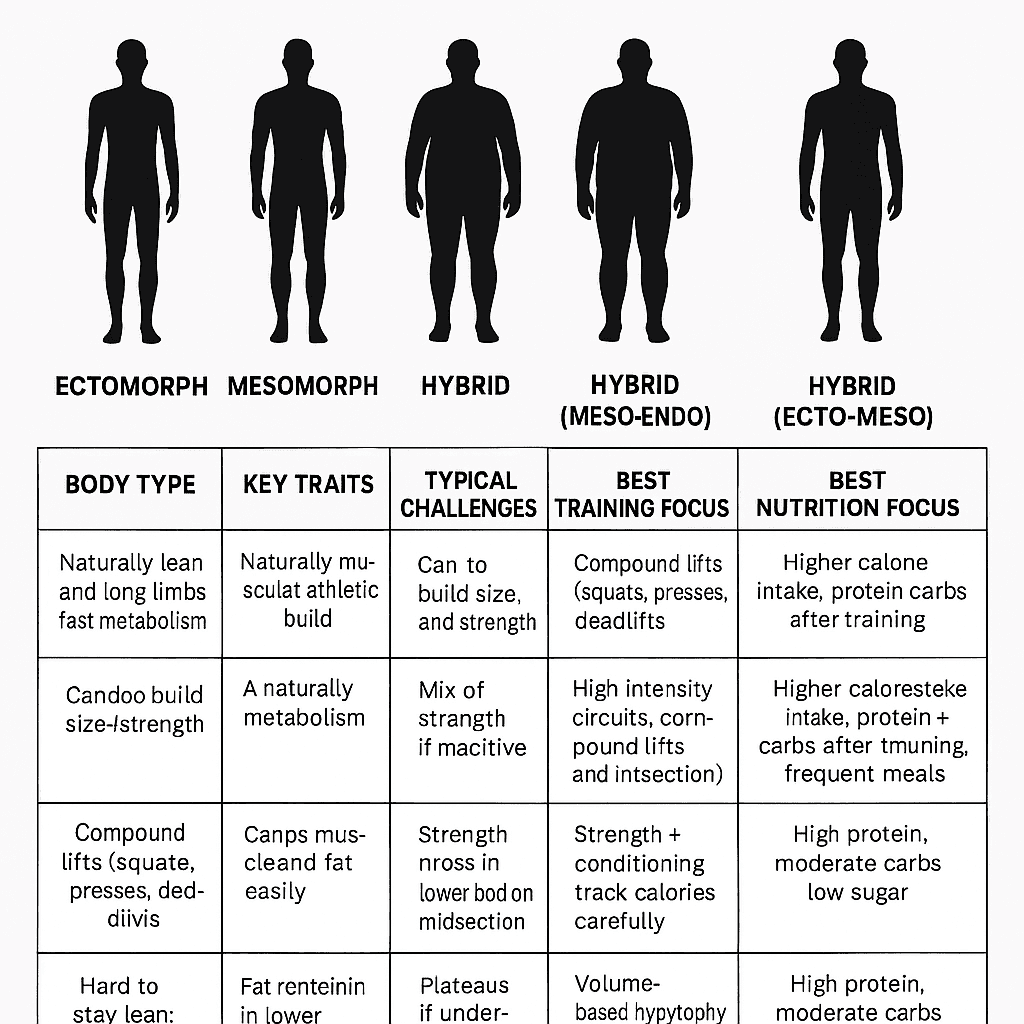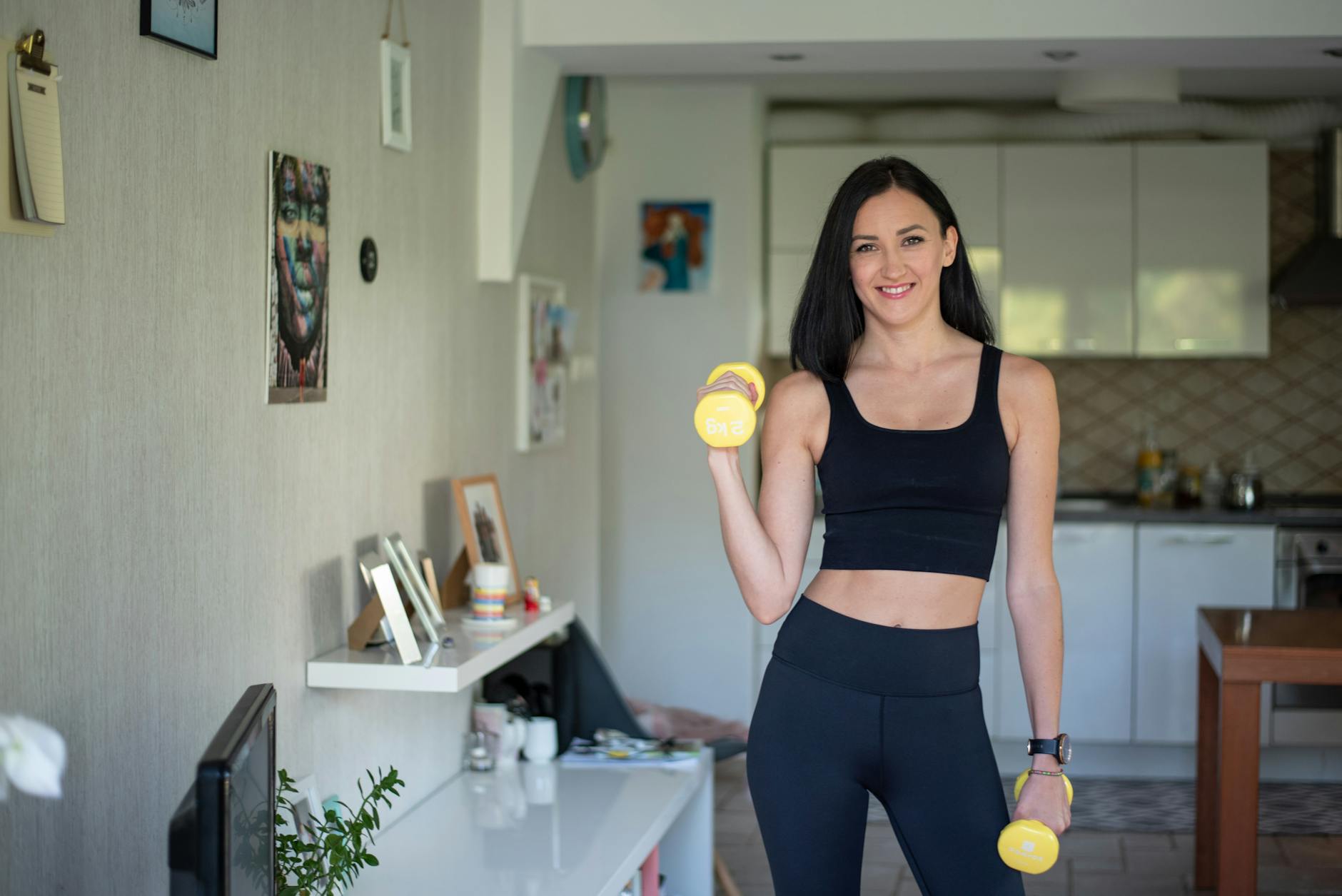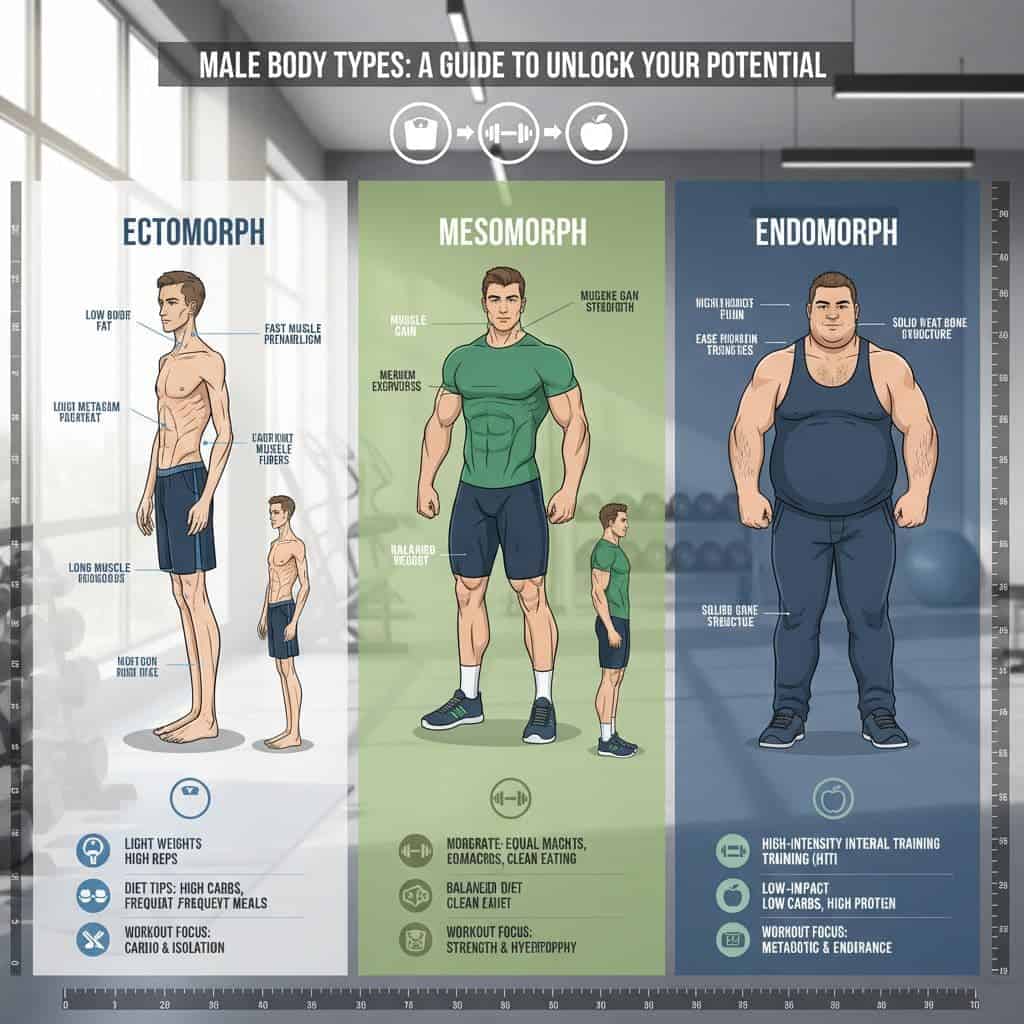Body Type Workouts at Home. Busy, over 30, and short on time? I get it. You want results without a garage full of machines or an hour-long commute to the gym.
That is why I built this simple, science-backed guide for men who wish to make progress at home, using little gear and innovative programming that matches how you are built.
Here is the key: your body type is a guide, not a label for life. Think of it like a starting map. The three classic somatotypes are easy to grasp: naturally lean, naturally athletic, and gains fat more easily.
Get your free Google Sheets progress tracker nowI will show you how to spot yours in minutes, then plug in a 30-minute plan that works.
This guide covers body type workouts with minimal equipment at home so you can train smart without a full gym. I will also cover how to find your build, how a body type calculator can help, and what a body type chart male looks like in real training.
You will leave with a quick ID method, exact workouts by type, a weekly schedule, and easy progress rules you can follow today.
Send me weekly workout tipsKey Takeaways
- Body types guide your strength training focus, not your limits.
- Minimal gear works if you hit the big patterns and progress weekly.
- Men 30 plus thrive on smart warm-ups, steady steps, enough protein to build muscle, and good sleep.
- Pick your closest match, run the plan for 4 to 6 weeks, then adjust based on results.
Table of Contents
How to find your body type at home in 3 steps

You can find your somatotype at home with a mirror, a tape measure, and a short self-check. Keep it simple. This is about making faster choices, not boxing yourself in for life.
If you have searched for how to find your body type or tried a body type calculator, you already know the basics. You can use the quick checks below, then skim the male body type chart to match a plan.
- Mirror check: look at your frame. Are you narrow and lean, broad and athletic, or thicker with a softer midsection?
- Tape check: measure your wrist and waist. Small wrists often signal ectomorph traits. A larger waist for your height often pairs with endomorph traits.
- History check: think about how you respond to training and food. Do you gain muscle easily or slowly? Do you gain fat quickly?
If you feel mixed, pick the closest match and commit to 4 to 6 weeks. Let your photos, strength, and waist tell the truth, then tune from there.
Use a simple body type calculator or self-check
Here is a quick flow I use:
- Wrist size relative to forearm
- Small and bony, watch straps sit loose: ectomorph sign
- Solid, medium build: balanced sign
- Thick and sturdy: endomorph sign
- Shoulder to hip look
- Narrow shoulders, straight line down: ectomorph sign
- Broad shoulders, V-shape or athletic taper: balanced sign
- Hips and waist similar width, thicker core: endomorph sign
- Muscle and fat gains
- Struggle to gain weight, even when eating more: ectomorph sign
- Build muscle fast, stay fairly lean: balanced sign
- Gain weight easily, need structure to lean out: endomorph sign
- Energy in training
- Burn out fast on long sets, need longer rest: ectomorph sign
- Handle intensity well, recover quickly: balanced sign
- Do better with steady circuits and walks, not all-out sprints: endomorph sign
Ectomorph signs: small joints, lean frame, hard gainer, better with longer rests. Endomorph signs: thicker frame, stores fat easier, thrives on circuits and steps.
You can cross-check your notes with a body type calculator to confirm your best fit. If results look mixed, do not overthink it. Most men are a blend. Pick the dominant pattern and move forward.
For extra context on bodyweight training done right, I like the practical exercise ideas in Unlock True Strength with These 20 Bodyweight Exercises.
Body type chart male: what it means for training
Use this quick map to set reps, rest, and focus for resistance training. Simple rules beat complex plans.
Body TypePrimary FocusReps per SetSetsRest per SetTempo TipEctomorphHigher total volume, push load slowly8 to 123 to 460 to 90 s3 seconds down on strengthMesomorphBalanced strength and conditioning6 to 10360 to 90 sControlled, smooth repsEndomorphCircuits, density, daily step targets8 to 12330 to 45 sCrisp reps, steady breathing
If you want a broader home routine primer, this breakdown from Healthline lays out solid fundamentals in Workout Routines for Men: How to Reach Your Fitness Goals.
Men 30 plus: adjust for metabolism and joints
After 30, recovery and joint care matter more. Warm up for 5 minutes, use joint-friendly angles, and pick loads that leave 1 to 2 reps in the tank. Pain is a stop sign. Metabolism slows with age, so these adjustments help sustain progress.
- Protein supports hormones and muscle, especially in a calorie deficit.
- Walk daily and add core exercises. Steps drive recovery, fat loss, and cardio health.
- Sleep 7 to 9 hours so your body can grow and repair. This exercise foundation reduces setbacks.
These tweaks make any plan work better, faster, and with fewer setbacks.
Minimal equipment that covers every movement pattern
You do not need a rack and barbell to get strong. With a tight gear list, you can hit all five patterns in your at home workout: squat, hinge, push, pull, and carry or core. Keep it budget friendly, and start this week.

Photo by Polona Mitar Osolnik
Adjustable dumbbells: one set for all lifts
Adjustable dumbbells save space and money, and they make progressive overload easy for compound exercises. Change plates or dials, track your reps, and grow. Most men do well with sets that go up to 52.5 pounds per hand, while advanced lifters may prefer 90s.
- Progress even when weight jumps feel big. Add reps first, then increase load.
- Keep a simple log. Aim to beat last week by 1 to 2 reps.
I can compare options in the best adjustable dumbbells guide.
Bench or sturdy surface for presses and step-ups
No bench? No problem. Use a solid chair, a cooler, or a step. A flat surface expands your exercise list: incline push-ups, dumbbell presses, single-leg hip thrusts that target the glutes, and Bulgarian split squats all become simple at home.
Safety tips: test the setup, avoid soft cushions, and wedge the surface against a wall if needed.
Bands and bodyweight add smart variety
A light and a medium band go a long way. Think rows, face pulls, pull-aparts, assisted push-ups, and band leg extensions.
Pair bands with dumbbells on presses and rows for constant tension. Bodyweight exercises fill the gaps: pushups, inverted rows under a sturdy table, split squats, and tempo air squats.
If you need a starter flow, Nerd Fitness offers an easy primer in The Beginner Bodyweight Workout: 20-Minute Routine.
Quick warm-up gear you already own
Use a jump rope, a towel for shoulder mobility, or a mini band if you have one. This routine prepares you for strength training in the main lifts. Try this 5-minute template, which includes core exercises like hip hinges and planks:
- 30 seconds easy cardio, like marching or rope
- 6 to 8 hip hinges
- 6 to 8 lunges per side
- 10 to 15 arm circles
- 20 seconds plank
Keep it simple so you actually do this exercise.
30-minute body type workouts with minimal equipment at home
Here are three plug-and-play exercise plans. Each uses adjustable dumbbells, bands, and a bench or sturdy surface. Warm up for 5 minutes and cool down for 3 minutes with easy walking and light stretching. Train 3 to 4 days per week based on your body type.
Ectomorph plan: build muscle with higher volume
Goal: size and strength. Train 3 days per week, with an optional 4th day for arms or calves.
This workout routine, 30 minutes:
- Goblet Squat, 4 x 8 to 12, rest 75 to 90 seconds
- One-Arm DB Row, 4 x 8 to 12 per side, rest 60 to 75 seconds
- DB Bench or Floor Press, 4 x 8 to 12, rest 60 to 75 seconds
- Romanian Deadlift, 3 x 8 to 10, rest 75 seconds
- Curl superset with Overhead Triceps Extension, 2 x 12 to 15, rest 30 seconds between
Tempo tip: 3 seconds down on each rep. Eat enough calories, hit protein, and keep cardio light. Walk on rest days to recover.
Download the free 30-minute Ectomporph workoutMesomorph plan: stay strong and lean with balance
Goal: performance and shape. Train 3 to 4 days per week, with two full-body workout strength days and one or two conditioning circuits.
Strength Day A:
- Split Squat, 3 x 6 to 10
- DB Row, 3 x 6 to 10
- DB Press, 3 x 6 to 10
- Hip Hinge, 3 x 6 to 10
- Plank, 2 x 30 to 45 seconds
Conditioning Circuit, 3 rounds for quality:
- 10 DB Thrusters
- 10 Bent-Over Rows
- 10 pushups
- 10 Reverse Lunges per leg
- Rest 60 seconds between rounds
Keep reps smooth, avoid failure, and leave 1 to 2 reps in reserve.
Download the free 30-minute Mesomorph workoutEndomorph plan: burn fat and protect muscle
Goal: fat loss with strength. Train 4 days per week, with two total-body strength circuits and two brisk walks or incline treadmill sessions.
Circuit template, 30 minutes:
- Goblet Squat, 3 x 10
- DB Row, 3 x 10
- Floor Press, 3 x 10
- Hip Hinge with focus on hip engagement, 3 x 10
- Farmer Carry or Static Farmer Hold, 3 x 30 to 45 seconds
These compound exercises form the key lifts. Move station to station with 30 to 45 seconds rest. Repeat the circuit 3 times. Keep steps at 8k to 12k per day on non-lifting days. Keep protein high, and place most carbs around your workouts.
For more no-equipment bodyweight workout ideas, this campus resource is handy: No Equipment Home Workouts: strength workouts.
Equipment swaps and space-saving tips
- No bench: use the floor for pressing.
- No step: use a chair for step-ups, or do Bulgarian split squats.
- No pull setup: do inverted rows under a sturdy table, or band rows.
- Limited weight: incorporate bodyweight exercises, add a pause or slow tempo, or use bands with dumbbells.
- For practical resistance training, if space is tight, keep your setup simple, not perfect. You can pick one plan and start.
Your weekly schedule, progression, and recovery
A clean weekly schedule keeps you consistent. Use a 3 or 4 day plan, set a 30 to 35 minute timer, and start on time. Progress in small steps, then repeat.
Sample 4-day week for busy dads and pros
These sample 4-day full-body workout plans are tailored by body type.
Ectomorph
- Mon Strength A
- Tue Walk or Mobility
- Wed Strength B
- Fri Strength A or Arms
- Sat Walk
Mesomorph
- Mon Strength
- Wed Conditioning Circuit
- Fri Strength
- Sat Hike or Bike
Endomorph
- Mon Circuit A
- Tue Walk
- Thu Circuit B
- Sat Walk
If a week gets hectic, run 3 days and keep your steps high.
Progressive overload made simple at home
Progress with three levers:
- Add 1 to 2 reps while keeping form tight.
- Add 2.5 to 5 pounds per dumbbell.
- Shorten rest by 10 to 15 seconds while holding the same reps.
Train around RPE 7 to 8 most days. If form is solid, push to RPE 9 on the last set. If joints feel beat up, take a lighter week every 5th week.
For home workout structure ideas, Healthline’s.
Recovery basics for men 30 plus: sleep, steps, protein
- Sleep: 7 to 9 hours to support metabolism and recovery.
- Steps: 8k to 12k per day.
- Protein: 0.7 to 1.0 grams per pound of goal body weight.
- Water: 80 to 120 ounces per day.
On off days, do 5 minutes of mobility for recovery from intense exercise. Limit alcohol to support sleep and fat loss. Stay consistent, not perfect.
Track results: photos, strength, waist, energy
Track weekly:
- Photos, front and side, same light and pose
- Top sets for key lifts
- Waist at the navel
- Morning energy and mood
If strength climbs and photos improve, keep rolling. If your waist grows while cutting, trim calories by 200 per day or add a 20-minute walk. Adjust based on data, not guesswork.
Get your free Google Sheets progress tracker nowFAQ
Q: Can I mix body type plans if I feel blended?
A: Yes. For a blended body type, start with the closest match. If you are in between, use the sets and rest from that plan and borrow one or two moves from the other. Retest after 4 to 6 weeks.
Q: How long until I see results?
A: Most men notice changes in 3 to 4 weeks, with clear progress in 8 to 12. Photos and strength logs will show it first, then the mirror.
Q: Do I need cardio on top of these workouts?
A: Walk daily. For extra fat loss or heart health, add 1 to 2 brisk 20 to 30 minute exercise sessions per week. Keep it conversational pace.
Q: What if my dumbbells feel too light?
A: To intensify your bodyweight workout, slow the tempo, add a 2 second pause at the bottom, or run a 1.5 rep pattern. Pair bands with dumbbells for more tension.
Q: Are body types real science?
A: They are patterns that help guide training focus. They are not destiny. Use them to set starting rules, then let your results lead.
Conclusion
Pick the body type that fits best, choose the matching 30-minute plan, and schedule your first workout this week. The plan is flexible, and progress comes from steady effort.
By using Body Type Workouts at Home, you can get stronger, build muscle, lose weight, and feel better in 30 minutes a day.
Please look over the gear and setup notes for your convenient at-home workout, then start your first session today.


1 thought on “Body Type Workouts at Home: 30-Minute Plans That Fit Your Build”